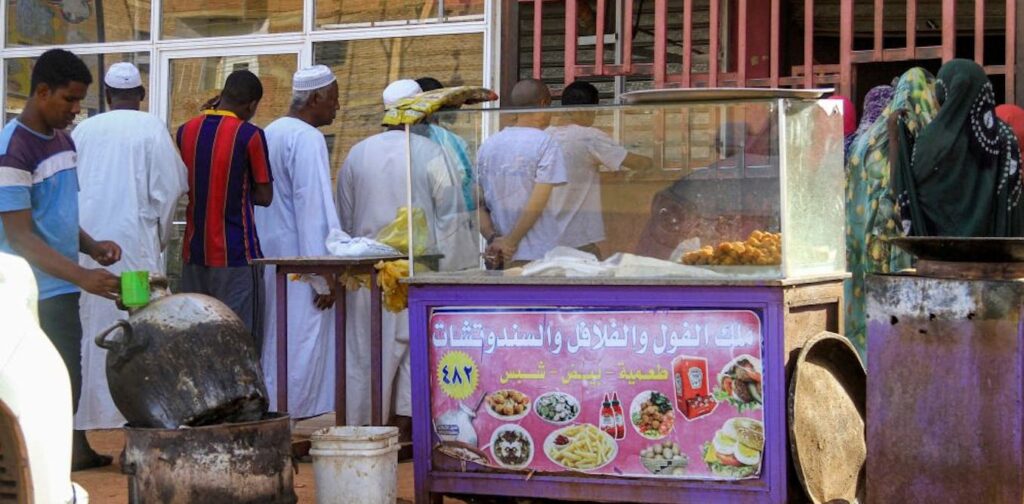After 14 months of escalating civil war, Sudan is facing its most severe food security crisis on record. The latest situation report, released on June 27, paints a grim picture: more than half of the country’s 47.2 million people face severe food insecurity, meaning severe food shortages, severe malnutrition and deadly hunger.
Without urgent action, there is also an increased risk of famine in multiple regions – a severe and widespread food shortage that leads to extreme hunger, malnutrition and increased mortality among the population.
Food insecurity is measured on the widely accepted five-point Integrated Food Security Classification (IPC), ranging from “marginal” (people have enough food) through “stress,” “crisis,” and “emergency” to “famine” (extreme food shortage, starvation, and very high mortality). The scale is intended to help governments and other humanitarian organizations quickly assess the situation and take action.
The deteriorating situation in Sudan is due to an escalation in conflict between Sudanese armed groups and organized violence in the country’s civil war that began in April 2023. This has made food security monitoring particularly challenging. The IPC’s Technical Working Group for Sudan faces significant challenges in updating its assessment analysis, including security threats, lack of physical access, and data gaps in hotspot areas.
Still, in March the UN issued a warning about the situation and the need for urgent action to prevent famine. New analysis, conducted in late April and early June, confirms the worst fears.
We are agricultural economists with over 50 years of combined research experience. Our recent work has included hunger in Gaza, research and prevention issues, and food security and social assistance in Sudan during armed conflict. With no end to the conflict in sight and humanitarian assistance difficult to deliver, our view is that the outlook for tens of millions of people in Sudan is dire.
Rapid rise in severe food insecurity
In its December 2023 analysis, the IPC projected that 17.7 million people (37% of the population) could face crisis-level or worse conditions between October 2023 and February 2024. Of these, 4.9 million are in a food “emergency” situation. The situation has since deteriorated dramatically.
Around 21.3 million people are estimated to have faced severe food insecurity across Sudan in April and May, including 153,000 people in famine-like situations, the most severe stage of the food insecurity classification. Between June and September 2024, the number of people facing crisis-level acute food insecurity could rise to 25.6 million, a 45 percent increase from the previous forecast period (October 2023 to February 2024).
In this scenario we predict:
Conflict continues, particularly in North Darfur, West Kordofan, South Kordofan, Khartoum and Al Jazeera states, leading to an increase in displacement, with the more densely populated southeastern states also affected.
Economic shocks from conflict-related unrest lead to economic contraction, higher inflation, and below-average food production.
Market disruptions, especially in key trading hubs, have exacerbated food shortages and high prices.
Food security is further complicated by limited humanitarian access, particularly in conflict-affected areas, and above-average rainfall may lead to flooding, although it does provide some agricultural opportunities in accessible areas.
During the same period, 14 districts in nine states were at increased risk of famine, with Greater Darfur, Greater Kordofan, Al Jazeera and parts of Khartoum being the worst affected.
The IPC projects that the food security situation may improve somewhat between the harvest seasons of October 2024 and February 2025. As a result, the total number of people facing crisis levels or above food insecurity could fall to around 21 million. However, 109,000 people would still be in famine-like situations.
Main factors
The main cause of this rapidly deteriorating situation is the escalating conflict and instability in Sudan, which has restricted the movement of goods and services, disrupted markets, hindered agricultural production and access to humanitarian assistance, severely reducing food supplies and access for millions of Sudanese.
The food crisis is not a new phenomenon. It is part of a recurring triple crisis syndrome consisting of a long-running civil war, climate shocks and economic instability. Besides the ongoing war between the Sudanese army and emergency response forces, the country has a history of serious civil conflicts in recent years, including Africa’s longest-running civil war (1983-2005) and the Darfur crisis (2003).
These have led to economic hardship, including rising prices of basic necessities, severely reducing access to food for large segments of the population.
In addition, climatic shocks, including prolonged droughts and severe floods, have devastated crop yields and livestock. Domestic grain production in 2023 is estimated to be 46 percent lower than in 2018.
The conflict has forced more than 10 million people to flee. There are currently 10.1 million internally displaced people and 2.2 million refugees in Sudan, making it the country with the highest number of forcibly displaced people in the world. Internally displaced people and refugees have lost their livelihoods and are highly dependent on humanitarian assistance. With conflict hindering their access to such assistance, they are the people most at risk of hunger.
The economic situation has worsened recently, with disruptions to supply chains and production capacity pushing up already sky-high prices for food and other basic goods. In some parts of the country, prices of staple goods have risen three times since May compared to the five-year average.
Can widespread famine be avoided?
To avert famine, the IPC Sudan Working Group also recommends the following immediate actions:
Restore humanitarian access to ensure humanitarian agencies have safe and continued access to the areas where people are most in need.
We will significantly increase the amount of food assistance and other essentials to prevent loss of life and support livelihoods.
Expand nutrition interventions, especially for vulnerable groups such as children and pregnant women.
We provide livelihood support, including distributing agricultural inputs and establishing safe zones for agriculture.
It is crucial that the international community responds swiftly to avert a humanitarian disaster in Sudan.


